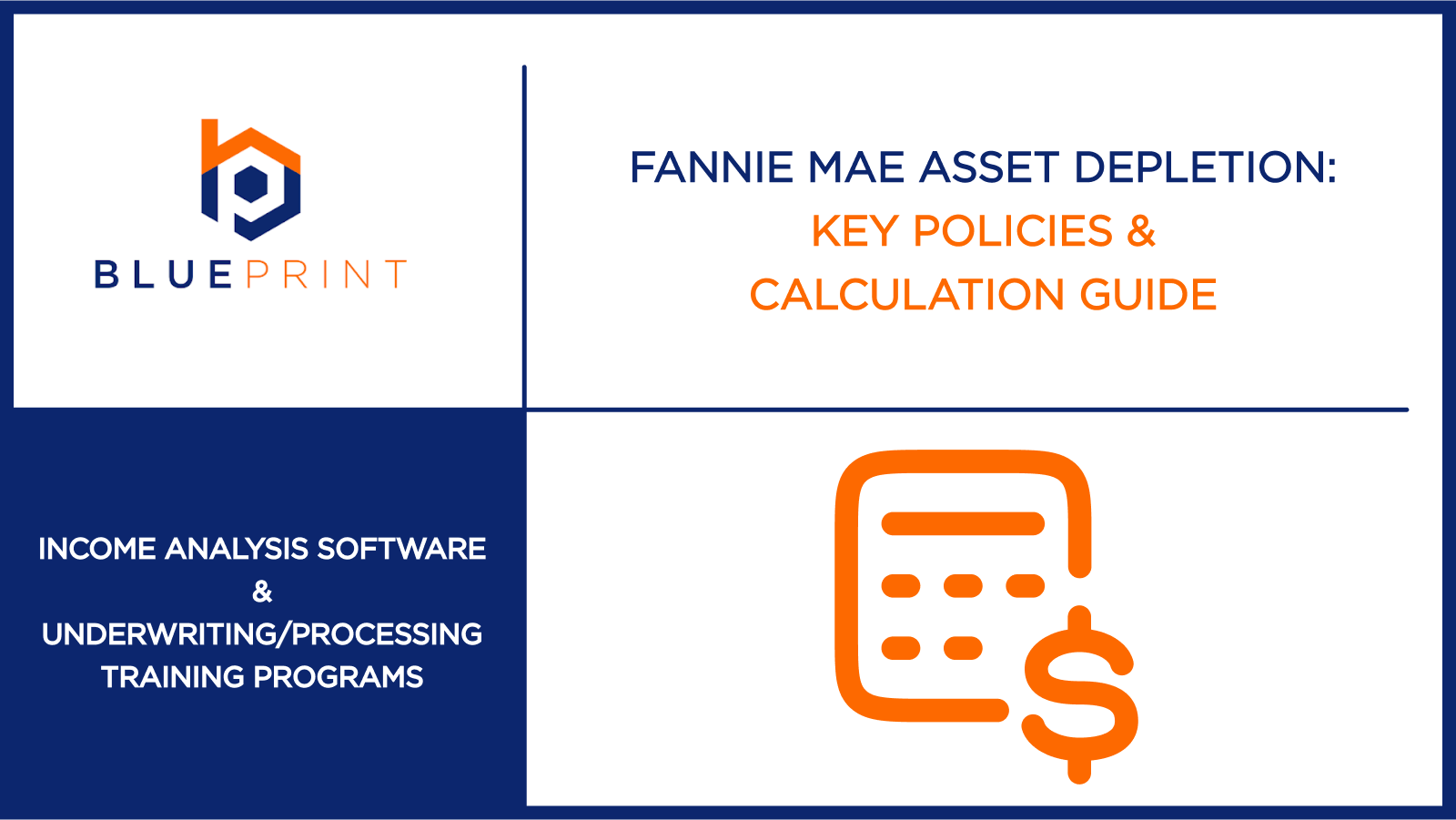Assessing borrowers with substantial accessible liquid assets but limited recurring income can present unique underwriting challenges. Fannie Mae’s asset depletion program offers lenders a way to qualify these borrowers by converting their accessible assets into a usable income stream for mortgage approval. This approach allows underwriters to recognize financial stability beyond traditional employment income and expand lending opportunities to retirees, self-employed individuals, and other asset-rich applicants.
This article provides a comprehensive overview of Fannie Mae’s asset depletion, as outlined in Selling Guide B3-3.1-099, outlining the specific eligibility criteria borrowers must meet and the method lenders employ to calculate asset-based income accurately for mortgage approval. It also highlights how tools like IncomeXpert can help automate and standardize asset-based income analysis for more efficient and compliant underwriting.
Main takeaways from this article:
- Fannie Mae’s asset depletion program allows borrowers to use liquid assets in qualified financial accounts to qualify for mortgage approval by transforming them into income.
- Eligible assets include 401Ks, IRAs, Keogh retirement accounts, severance packages, or lump sum retirement distributions that meet specific requirements.
- The asset depletion process involves identifying eligible assets, calculating their total value, applying a depletion formula, and ensuring compliance with Fannie Mae guidelines.
- IncomeXpert helps automate the process, enhancing accuracy, ensuring guideline adherence, and reducing approval times for asset depletion loans.
What is Fannie Mae’s asset depletion program?
Fannie Mae’s asset depletion program permits lenders to consider a borrower’s liquid assets as a source of qualifying income for mortgage loans. Lenders can calculate a monthly income figure based on a portion of the borrower’s accessible funds, which allows individuals who may be retired, self-employed with fluctuating income, or have considerable savings to qualify for a mortgage. By recognizing that substantial liquid assets can support monthly mortgage payments, the program promotes homeownership for those with strong asset positions.
Fannie Mae’s asset depletion eligibility criteria

Fannie Mae has set the following eligibility criteria that borrowers must meet to qualify for the asset depletion program. These criteria ensure that borrowers using asset depletion have the necessary financial stability and readiness for mortgage repayment.
Eligible asset types
To qualify for asset depletion, specific types of assets are deemed acceptable. The following asset types are some examples:
- Retirement accounts: Funds held in retirement accounts, such as 401(k)s, IRAs, and Keogh plans, can be used.
- Severance Packages or Lump Sum Retirement Distributions: Non-self-employed severance packages or lump sum retirement distributions are acceptable. These funds must be documented with a distribution letter from the employer (Form 1099-R) and deposited into a verified asset account.
Minimum asset balance requirements
Fannie Mae does not mandate a fixed minimum remaining balance after applying asset depletion, but lenders must ensure that borrowers have sufficient reserves to cover mortgage payments over the term of the loan. The required reserve amount may vary based on factors such as loan size, borrower profile, and overall risk assessment.
Asset holding period
Fannie Mae does not specify a strict minimum holding period for all eligible assets, but lenders will scrutinize the source and history of the assets.
Large, recent deposits without a clear and acceptable explanation may raise concerns and require further documentation to ensure the funds are genuinely the borrower’s and not borrowed to qualify for the mortgage.
Borrower’s financial documentation
If a borrower wants to leverage asset depletion to qualify for a loan, they will need to supply detailed documentation, which includes bank statements, brokerage account statements, retirement account statements, and other relevant financial records, proving their ownership of and ability to access said assets.
The lender will then review these documents carefully to ensure the assets are owned by the borrower, are readily available, and have a verifiable value.
Asset depletion calculations for mortgage approval

The calculation of asset depletion involves the steps below to determine a monthly income figure that can be used in conjunction with or in lieu of traditional income for mortgage qualification.
1. Identify eligible assets
The first step is to identify all liquid assets owned by the borrower that meet Fannie Mae’s eligibility criteria, as outlined previously.
2. Calculate the total value of liquid assets
Once the eligible assets are identified, the lender must determine their total current value. For investments, this is the current market value as of a recent statement date.
The supplied documentation will also be used to determine retirement account balances and the cash value of life insurance policies.
3. Determine the asset depletion period
Fannie Mae allows lenders to use a specific timeframe, typically 360 months (30 years), to deplete the identified assets. However, lenders may have the discretion to use a shorter period based on factors such as the borrower’s age or financial profile.
4. Apply the depletion formula
Lenders then apply the depletion formula to calculate the borrower’s income derived from the total asset value over the determined depletion period. The formula for calculating the monthly income derived from asset depletion is:
Total Value of Eligible Assets ÷ Depletion Period (in months) = Monthly Asset-Based Income
For example, if a borrower has $360,000 in eligible liquid assets and the depletion period is 360 months, the monthly asset-based income would be $1,000 ($360,000 / 360 = $1,000).
5. Assess the borrower’s remaining income
After calculating the asset income, consider it in conjunction with any other regular income the borrower may have. The total qualifying income must be sufficient to meet the monthly payment, property taxes, insurance, and other housing-related expenses, as well as the borrower’s other debt obligations.
6. Verify compliance with Fannie Mae guidelines
Throughout the calculation process, lenders must adhere strictly to Fannie Mae’s requirements outlined in Selling Guide section B3-3.1-09, including eligible asset types, minimum balance requirements, and the permissible depletion period. Any deviations from these guidelines can result in non-compliance.
Common errors in asset depletion loan assessments

Several common mistakes can occur when assessing borrowers using the asset depletion method:
- Not following the loan parameters: This income source can only be used on primary and second homes with lower LTV restrictions. The loan purpose is restricted to purchase or rate and term refinances.
- Misapplying the depletion period: A frequent error is using an incorrect depletion period. For example, using a depletion term that is different than the loan term.
- Incorrectly identifying eligible asset types: Including assets that do not meet Fannie Mae’s definition of liquid and accessible assets can lead to an inflated income calculation.
- Failing to account for asset dissipation: Not considering potential withdrawals or reductions in asset value that may occur during the loan process or the depletion period can result in an overestimation of available funds.
- Overlooking documentation requirements: Insufficient or incomplete documentation of the borrower’s assets can hinder the verification process and lead to compliance problems.
How IncomeXpert simplifies asset depletion approvals

Here’s how IncomeXpert simplifies asset depletion analysis to support faster, more accurate loan approvals:
Automates asset depletion calculations
IncomeXpert automatically computes the monthly income derived from a borrower’s qualifying liquid assets. Users can input the total value of eligible assets, and the system will apply the appropriate depletion period, typically the standard 360 months, to generate the asset-based income figure.
Ensures Fannie Mae compliance
The software is built with Fannie Mae’s asset depletion policies integrated into its framework. This helps lenders comply with the specific requirements regarding the types of assets that can be considered, the permissible depletion periods, and the necessary documentation.
Reduces errors and improves accuracy
Manual asset depletion analysis is susceptible to human error. IncomeXpert’s automated system provides a structured and consistent approach to asset depletion assessment. By standardizing the process and performing calculations automatically, the platform runs accurate income evaluations to deliver reliable loan decisions.
Speeds up approval and underwriting
The automation and standardization provided by IncomeXpert contribute to a faster overall loan approval process. Underwriters can quickly review the asset depletion calculations generated by the system, along with the supporting documentation, without the need for manual verification of each step.
Streamline asset depletion approvals with IncomeXpert
For lenders looking to simplify their asset depletion process and enhance compliance while reducing errors, IncomeXpert presents a valuable solution.
The tool offers mortgage professionals an easy way to efficiently and accurately process loans utilizing Fannie Mae’s asset depletion program. By automating calculations, ensuring compliance, and reducing errors, IncomeXpert simplifies the process and allows lenders to improve their operational effectiveness.
To learn more about IncomeXpert and how it can transform your asset depletion approval process, request a demo today.

